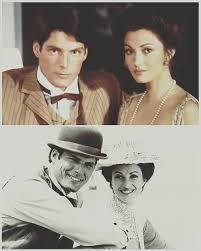In the summer of 1979, the team behind Somewhere in Time discovered that filming at the Grand Hotel on Mackinac Island came with an unusual challenge. The hotel was in the middle of its busy tourist season, packed with vacationers. Instead of closing it down, director Jeannot Szwarc and his crew had to weave their work around the daily life of the guests. Extras dressed in Edwardian costumes sometimes found themselves standing next to real vacationers who had wandered into frame. Filming often stopped so meals could be served, tours could continue, or ballroom music could play. The line between the film’s staged time travel and real life blurred so much that even the cast admitted it was hard to tell where reality ended and fantasy began.
The story itself came from Richard Matheson’s fascination with fate and time. While staying at the Hotel del Coronado in California, he saw a portrait of actress Maude Adams from decades earlier. That single image sparked his imagination and eventually became the basis for his novel Bid Time Return in 1975. In the book, a modern man wills himself back in time after falling in love with a woman from the past—just as Christopher Reeve’s Richard Collier would do on screen when he sees Jane Seymour’s Elise McKenna’s portrait in the Grand Hotel.
Mackinac Island, with its ban on cars, felt like the perfect setting. Everything had to be hauled by horse-drawn wagons, and the cast often traveled by carriage. Locals still recall catching glimpses of Reeve walking the waterfront in costume, or Seymour wandering through gardens in elegant Edwardian gowns. For a brief time, it seemed the island itself had slipped back to 1912, the very year the film’s story takes place.
One of the crew’s strangest routines involved the hotel’s grand dining room. Because it had to serve guests during the day, the crew would sneak in after midnight to transform it into a movie set. They rolled back carpets, adjusted chandeliers, and set up cameras quietly so as not to wake anyone upstairs. By morning, everything was restored as if nothing had happened. It gave the filmmakers the odd feeling that they were stealing time themselves—fitting for a movie built on the idea of bending it.
The music gave the film its soul. Composer John Barry, famous for his James Bond scores, had recently lost his wife. That grief shaped the haunting melody of Somewhere in Time’s theme, a piece so moving that even long after filming ended, it was still played in the hotel’s ballroom. The music captured both the romance of the story and the ache of fleeting moments.
When the shoot wrapped, locals and guests carried away stories almost as magical as the film itself. Some remembered seeing actors in period clothing at odd hours. Others swore they heard music drifting through the halls with no orchestra in sight. For many, the island felt touched by the past in ways that lingered.
Though Somewhere in Time struggled when it premiered in 1980, it slowly found its audience and became a cherished classic. Its lasting charm lies not only in Matheson’s love story or the performances of Reeve and Seymour, but also in the unusual way it was made. The mix of inconvenience, coincidence, and quiet magic behind the camera gave the film an authenticity that can still be felt today.✍️
